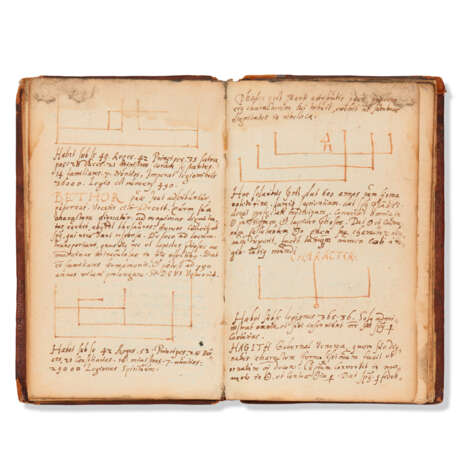ID 869544
Lot 137 | Jacques Gohory?
Valeur estimée
£ 4 000 – 6 000
Arbatel, De Magia, seu Pneumatica Veterum, in Latin, decorated manuscript on paper [Germany or Switzerland, late 16th century].
A practical and concise grimoire of Renaissance ceremonial magic, cited by John Dee in his Mysteriorum Libri, often quoted and reprinted, ‘its impact on western esoteric philosophy [...] overwhelming’. The present manuscript copy is contemporary with its earliest appearance in print.
119 x 72mm. ii + 24 + ii leaves, complete, c.27 lines of text written in black ink in small italic hand, rubrics in pale red, 3 pages with diagrams (marginal dampstaining, especially to opening leaves, some smudges to text). 19th-century calf, gilt title on red morocco label: ‘Arbatel De Magia’ (edges scuffed, lacking calf on spine).
Provenance:
(1) Georg Kloss (1787-1854), of Frankfurt-am-Main, German doctor and historian of freemasonry: his ownership inscription dated 1811 on f.23v.
(2) ‘No. 25. No. XXXIII Nr, Wilsons Catalogue for 1831’: inscription on f.ii verso. Perhaps a match with a Schoenberg Database record showing an Arbatel ‘De Magia’ sold at Sotheby’s, Catalogue of a valuable collection of autograph letters of distinguished persons [...], 20 May 1831, lot 116.
(3) John Lee (1783-1866), born John Fiott, English philanthropist, astronomer, mathematician, antiquarian, barrister and numismatist: his inscription ‘J.Lee Doctors Commons. Repaired. 1831’ and bookplate, with the Lee coat of arms and muzzled bear quartered with the Fiott coat of arms and rampant horse. His sale at Sotheby’s, The Library of a late well-known collector, 8 November 1888, lot 62.
(4) Dealer’s (Stonehill?) typed catalogue entry tipped into upper board, no 1143.
(5) Colker MS 2, with his ownership inscription ‘Sum ex libris Marci Leonardi / 19x43’, f.1; acquired from Stonehill in 1943; Faye & Bond, Supplement to de Ricci’s Census. (1962), p. 516.
Content:
Arbatel, De Magia, divided into seven Septenaries of 49 Aphorisms, beginning ‘Nunc primum ex tenebris in lucem producta [...]’, and ending ‘[...] et quatenus unicuique insudandum sit ad competentem vitae, et vivendi terminum’ ff.1-23; diagrams representing the seals, or ‘characters’ of the Princes of the Seven Governments (the so-called ‘Olympian Spirits’), Aratron, Bethor, Phaleg, Och, Hagith, Ophiel and Phul, ff.7v-8v.
Composed some time after the 1530s, the Arbatel was first published by Peter Perna in Basel in 1575. The text of the present manuscript follows that edition closely, and the script is not dissimilar from one of the earliest manuscript copies of the text in the Research Library at Olomouc (MS 5265). There has been much debate as to the meaning of the word ‘Arbatel’. A.E. Waite, in his Book of Ceremonial Magic, assumed that it derives from the Hebrew ‘Arbotal’ as the name of an angel from whom the author drew his magical knowledge. Adolf Jacoby believed it to be a reference to the Tetragrammaton, via the Hebrew ARBOThIM (fourfould) and AL (or God) (see A. Jacoby, Bächtold-Stäubli, Hanns, Handwörterbuch des deutschen aberglaubens, 1927, p.568). J.H. Peterson, who has published the most recent and comprehensive edition of this work (Arbatel: Concerning the Magic of the Ancients, 2009), suggests that the title might be the author’s pseudonym, and tentatively attributes the work to the Paracelsian Jacques Gohory (1520-1576).
The text focuses on the positive relationship between humanity and celestial hierarchies: it is deeply rooted in classical culture, the Sibylline oracles, Plotinus, and more contemporary occult figures such as Johannes Trithemius, Pontanus and Paracelsus. It contains a detailed explanation on how to construct the ‘Seal of Secrets’, a quadrant used to communicate with the Spirits or Angels and learn their God-given secrets (‘Usus huius secretorum sigilli est ut scias unde producantur Spiritus seu Angeli, qui secreta a Deo tradita doceant’, see f.12v-13v), and what is possibly the first appearance of the word ‘Theosophy’ in an occult sense (see the table on f.23). The Arbatel was tremendously influential throughout the late Renaissance, inspiring not only John Dee, but also other major occult figures such as Robert Fludd, Johann Arndt, Gerhard Dorn and Valentin Weigel.
| Catégorie maison de vente aux enchères: | Manuscrits médiévaux et de la Renaissance |
|---|
| Catégorie maison de vente aux enchères: | Manuscrits médiévaux et de la Renaissance |
|---|
| Adresse de l'enchère |
CHRISTIE'S 8 King Street, St. James's SW1Y 6QT London Royaume-Uni | |
|---|---|---|
| Aperçu |
| |
| Téléphone | +44 (0)20 7839 9060 | |
| Commission | see on Website | |
| Conditions d'utilisation | Conditions d'utilisation |





